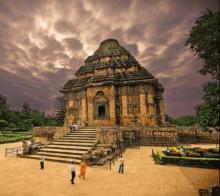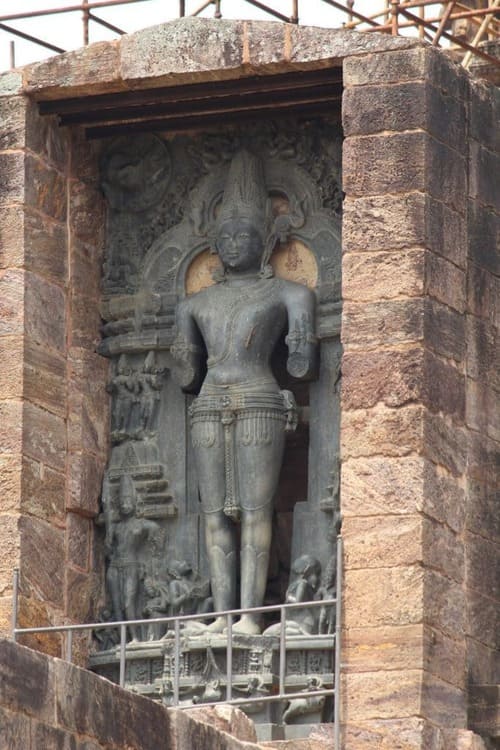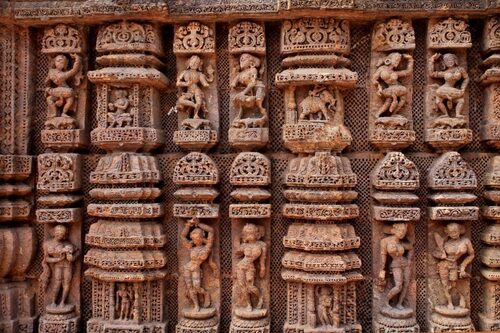
As a UNESCO World Heritage Site, the Konark Sun Temple stands as a remarkable testament to ancient craftsmanship, the flow of creative ideas, and a repository of knowledge.
Devoted to the Sun God, Surya, the temple's entrance is where the first rays of the sun touch each day. While a significant portion of the temple has deteriorated over time, the remaining structure retains enough allure to enchant visitors.
An embodiment of boundless imagination, it has witnessed the ascent and decline of empires, the erosion of identities, and yet continues to appeal to our senses even in the present day.
Konark Sun Temple mysteries
India is home to hundreds of ancient and magnificent temples, some of which are architectural marvels that continue to baffle modern engineering and science. Among these, the enigmatic Konark Sun Temple stands out. Interestingly, the temple's doors have remained closed for more than 118 years. Let's explore some perspectives that can help unravel the mysteries surrounding the Konark Sun Temple:
Surya Dev (God Sun) is not worshipped
The Konark Sun Temple remains unvenerated due to a historical event involving King Narasimhadeva and the temple's construction.
The king had set a strict deadline for the temple's completion, which was ultimately missed by Dadhi Nauti, endangering the lives of 1200 workers and the chief architect, Bishu Maharana.
In a remarkable turn of events, a young boy named Dharmapada emerged, claiming to be the son of Bishu Maharana and assuming responsibility for saving the lives of those 1200 workers.
In a bid to avert the tragedy, he courageously leaped from the temple's pinnacle into the Chandrabhaga River, seeking to humble the king's ego.
It is believed by many that this 12-year-old was an incarnation of the Sun god himself. Consequently, worship rituals have not been conducted within the Konark temple since that time.
Floating Idol & Magnet Effect
One of the most intriguing aspects of this temple was the suspension of the sun idol in mid-air, a feat attributed to the use of magnets in its construction.
Upon entering the main temple, visitors would behold a tall idol hanging suspended without visible support, a source of mystery for generations. It was not widely known at the time that this phenomenon was due to the magnetic fields generated from all four sides of the idol's enclosure.

However, this remarkable display ultimately led to the removal of the idol. Although historical evidence is scarce, many experts speculate that a massive 52-ton stone known as the "Lodestone" was placed within the temple, serving as a natural magnet. This "Lodestone" magnetically levitated the idol of Lord Surya within the Konark Sun Temple, a true marvel in its own right.
Various accounts now circulate about the fate of this magnet and its current whereabouts. The most prevalent theory suggests that the temple originally stood on the seashore, but over time, as the sea levels receded, the temple was relocated several kilometers away from the coast.
Konark Sun Temple architecture
The temple is renowned for its remarkable Kalinga architecture, featuring an intricate portrayal of a 100 ft tall chariot drawn by horses and wheels meticulously carved from a single piece of stone. This monument represents the majestic chariot of the sun god.
Constructed from Khondalite rocks, the original temple once housed a 230 ft tall sanctum (which no longer exists), along with a 128 ft tall audience hall, a dance hall, and a dining hall that still stand today.
Adorned with 24 intricately designed wheels, each with a 12 ft diameter and drawn by horses, this symbolism includes seven horses representing the days of the week, 12 wheels symbolizing the months, and the eight spokes within the wheels representing the day-cycle.

This entire depiction illustrates how the sun, embodying Surya in Hindu mythology, controls time as it travels from the east in its chariot, escorted by its charioteer, Aruna.
The entrance leads to the shrine of the deity Surya, crafted from chlorite stone. The temple's walls are embellished with intricate reliefs, showcasing various figures, including Hindu deities, scenes from everyday life, birds, animals, and more.
Additionally, the temple features erotic sculptures on its shikhara, which belong to the tantra tradition. Notably, the temple's wheels can function as sundials, accurately predicting the time.
Best Time to Visit
Konark, being a coastal town, experiences the most pleasant weather during the winter season. Hence, the best period to explore this location is from September to March, which corresponds to the winter months. Summers in Konark are known for their extreme heat and high humidity, making it advisable to avoid visiting during this season.
☀️Summer (March to June)
Konark endures a hot summer season with elevated humidity levels, although the heat here is relatively more tolerable when compared to other locations in Odisha. It is advisable to refrain from planning a visit to Konark during this period.
⛈️Monsoon (July to September)
During the monsoon season, Konark experiences moderate rainfall, occasionally accompanied by cyclonic activity. The highest rainfall occurs in August, contributing to an annual average rainfall of 152 cm. Monsoon rejuvenates the area, giving it a fresh appearance.
❄️Winter (October to February)
Konark offers a delightful experience during the winter season, with temperatures dropping to around 15 degrees Celsius. This period is considered the optimal time to visit Konark and fully enjoy your trip. It's an ideal season for sightseeing and exploring both the city and the coastline.
How To Reach
The Konark Sun Temple is located in the Puri district, approximately 60 km away from Bhubaneswar, the capital city of Odisha. Konark is a popular tourist destination primarily due to its magnificent Sun Temple, and as a result, it maintains excellent connectivity with Bhubaneswar and Puri through train services, buses, and taxi options. Here are some dependable means of reaching the temple.
✈️ By Air
The Biju Patnaik International Airport in Bhubaneswar is located approximately 65 km away from the temple, and the journey typically takes about an hour by road.
Once you arrive at the airport, you have the option to hire a taxi from Bhubaneswar airport to reach your intended destination.
🚝 By Train
The nearest railway station to the Konark Temple is Puri Railway Station, situated at a distance of approximately 30 km. To reach the temple, you can board trains from Bhubaneswar to Puri and then arrange for a cab to complete your journey.
🚗 By Road
Odisha boasts well-constructed roads that provide excellent transportation services for travelers. Therefore, if you prefer to travel by road to the temple, you can easily reach your destination by either booking a cab in Konark or using the bus services available.
The Konark Bus Stand is conveniently located just 6 minutes away from the Sun Temple. If you're coming from Puri, you can catch a bus that will take approximately an hour to reach Konark. Both OSRTC (Odisha State Road Transport Corporation) and private bus operators offer services from Puri to Konark.
Konark Sun Temple Opening Timings
The opening hours of the Konark Sun Temple are from 6 am to 8 pm - All Days Open.
FAQs
Question: When was the Sun temple constructed and for what purpose?
Ans: The Konark Sun Temple, dating back to the 13th century, was erected as a dedication to the Hindu Sun Lord, Surya. It is attributed to King Narasingha Deva I of the Eastern Ganga Dynasty. Another theory suggests that Krishna Samba, the son of Lord Krishna, had the temple built to honor the Sun Lord after his son was cured of an illness by Surya.
Question: What makes the Sun temple famous?
Ans: The Konark Sun Temple, a UNESCO World Heritage site, is renowned for its exceptional architecture. Its intricate geometrical patterns and carved wheels once functioned as sundials. The temple features three images of the Sun God positioned to capture the sun's rays at dawn, noon, and sunset. Additionally, the temple's carvings of deities, mythological creatures, and erotic sculptures contribute to its fame. Due to its dark color, it was referred to as the Black Pagoda, and ancient sailors used it as a navigational landmark.
Question: What is the admission fee for the Sun temple?
Ans: The entry fee for the Sun Temple varies for Indian and foreign visitors. Foreign tourists are charged INR 550 per person, while Indian nationals, as well as SAARC and BIMSTEC visitors, pay INR 35 per person.
Question: What are the visiting hours for the Sun temple?
Ans: The Konark Sun Temple is open to tourists from 10:00 am to 5:00 pm, and it welcomes visitors every day of the week.
Question: What is the most convenient way to reach the Sun temple?
Ans:The nearest airport to the Sun Temple is the Biju Patnaik International Airport in Bhubaneswar, located 62 km away (approximately 1 hour and 39 minutes). You can either hire a prepaid taxi from the airport counter or take a bus from outside the airport to reach the temple.
The closest railway station is the Puri railway station, situated 36 km from the Konark Sun Temple. You can find numerous taxis and cabs outside the railway station to transport you to the Sun Temple, with the journey taking roughly 50 minutes.
The nearest bus stand is the Konark Bus Stand, just 6 minutes away. Both private and public bus operators, such as OSRTC, Dolphin Tour and Travels, Shyamoli Paribahan Pvt. Ltd, and Diwakar Travels, provide transportation to the Sun Temple.

